While some prefer rowing on an open lake on a beautiful day, the best rowing machines can get you that rush without hitting the water. High-intensity interval training (HIIT) is an efficient way to get your cardio done quickly. HIIT rower workouts tax your whole body as you push, pull, and challenge your cardiovascular system.
HIIT is intense by nature, but we’ve got HIIT rowing workouts for all fitness levels so beginners can start building their conditioning. We’ll also give you tips for programming your rowing sessions and outline the top benefits of HIIT. Picture that open water, and let’s get rowing.
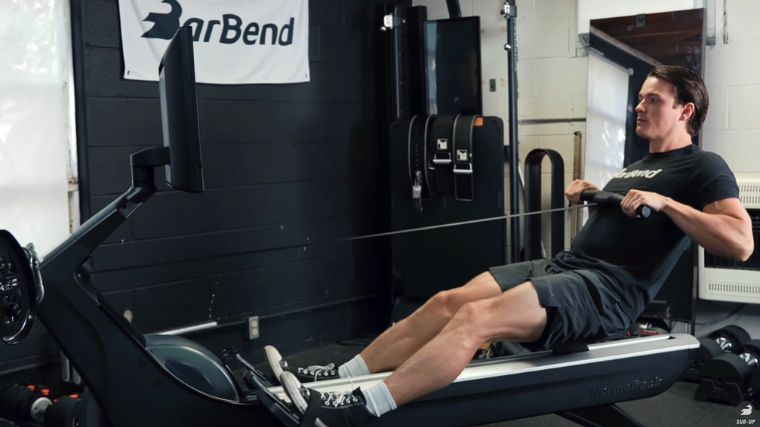
Editor’s Note: The content on BarBend is meant to be informative in nature, but it should not be taken as medical advice. When starting a new training regimen and/or diet, it is always a good idea to consult with a trusted medical professional. We are not a medical resource. The opinions and articles on this site are not intended for use as diagnosis, prevention, and/or treatment of health problems. They are not substitutes for consulting a qualified medical professional.
HIIT Rowing Workouts
The rowing machine, sometimes called a rower or an erg, is set up to give you a full-body workout that mimics the pattern of rowing on the water. We like it because it’s excellent for HIIT workouts, steady-state cardio, interval workouts, and sweaty finishers to build conditioning after lifting.
[Read More: The 8 Best Budget Rowing Machines]
We’re here to focus on HIIT — that method of training where you put in all-out efforts, rest, and repeat. So let’s jump into the best HIIT rowing workouts for beginners, intermediates, and advanced athletes.
Beginner HIIT Rowing Workout
First thing first: as a beginner, you want to nail your rowing technique. Not sure how to use a rowing machine? Proper rowing form involves pushing through your legs, then pulling from your back through your arms, keeping your core tight, and breathing throughout. It’s a full-body workout, so be sure to engage your upper body and lower body.
High-intensity interval training requires short bursts of maximum effort followed by short periods of recovery or rest. This beginner workout has an equal balance of work and recovery. As a beginner, you may not want to go as hard as possible for your sprints because you could burn out quicker. True HIIT does call for an all-out effort, but start with what you can do.
It should feel like a high-intensity training, so we’ll leave you with some modification options. With a warm-up and cool-down included, it’s about a 16-minute row.
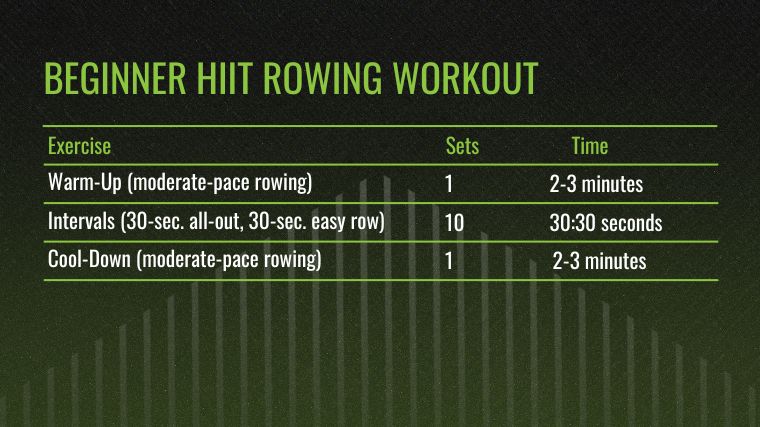
- Warm-Up: Two to three minutes of rowing at a moderate pace.
- 30:30 Intervals: Alternate 30 seconds of rowing as fast as possible with 30 seconds of easy rowing.
- Repeat for 10 rounds, for a total of 10 minutes.
- Cool Down: Two to three minutes of rowing at a moderate pace, reducing speed.
Equipment Needed: You only need a rowing machine for this workout.
How Often to Do This Workout: Beginners can incorporate this into their workout program by trying it twice a week.
Modifications
- Make it Easier: Change the intervals to 20 seconds of high-intensity to 40 seconds of recovery, or do less than 10 rounds.
- Make it Harder: Change the intervals to 40 seconds of high intensity and 20 seconds of recovery, or do 14 rounds to make it a 20-minute row.
Intermediate HIIT Rowing Workout
Intermediate athletes can try out a Tabata rowing workout. Tabata, named in 1996 by Japanese scientist Izumi Tabata, refers to a specific style of HIIT training. You do 20 seconds of all-out work, 10 seconds of rest, and repeat for eight rounds. While a four-minute row might not sound like much, the short rest times make it brutal. You can repeat this workout three times for 12 minutes total.
Research has shown that Tabata training helps improve VO2 max, aerobic, and anaerobic exercise performance. It’s a major challenge for your cardiovascular system. (1)
[Read More: Does Rowing Build Muscle? How to Get Ripped on a Rowing Machine]
Be sure to do a complete dynamic warm-up before you hop on the rower, and finish with some cool-down stretches.
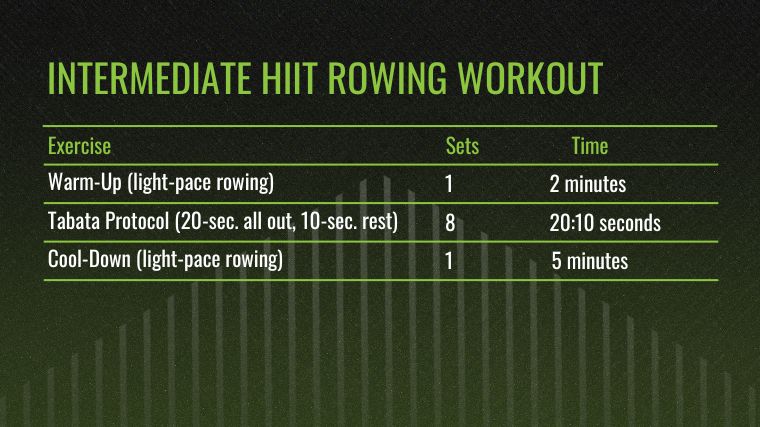
- Warm Up: Two minutes of light rowing.
- Tabata: 20 seconds of maximum effort-rowing, 10 seconds of complete rest. Repeat eight rounds.
- Repeat the Tabata sequence two more times, for three total.
- Cool Down: Five minutes of light rowing.
Equipment Needed: You’ll need a rower.
How Often to Do This Workout: Try this two to three times per week.
Modifications
- Make it Easier: Try one or two four-minute Tabata sequences.
- Make it Harder: You can do up to four Tabata sequences or increase your intensity during your 20-second bursts of effort.
Advanced HIIT Rowing Workout
For advanced athletes, we’re going to mix things up. This intense 20-minute HIIT workout combines the rower with three other exercises. You’ll be hopping on and off with no rest in between. It’s similar to something you may see at a CrossFit box and builds full-body strength and endurance.
[Read More: The 12 Best Rowing Machine Workouts for Every Experience Level]
This is an AMRAP (as many rounds as possible) workout. You’ll set a timer for 20 minutes and complete as many rounds as possible before it runs out. Go all out in effort and speed while maintaining proper rowing form.
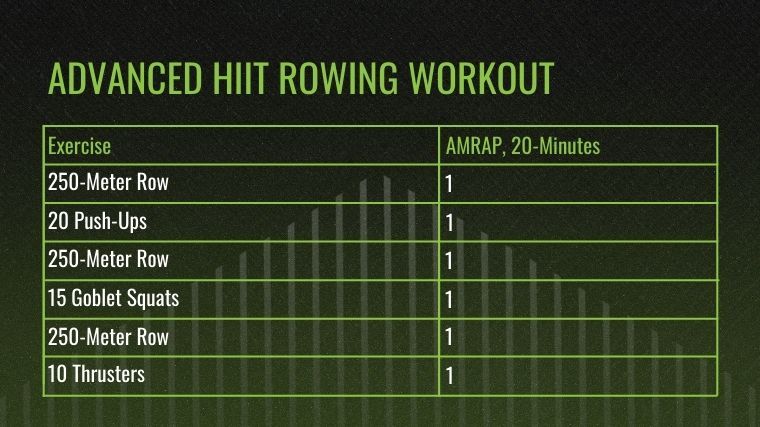
20-minute AMRAP
- 250-meter Row
- 20 Push-Ups
- 250-meter Row
- 15 Goblet Squats
- 250-meter Row
- 10 Thrusters
Equipment Needed: You’ll need a rowing machine and weight for your squats and thrusters — you can use a dumbbell, kettlebell, or barbell for thrusters.
How Often to Do This Workout: If you already have an intense workout routine, try doing this once a week and work up to two times.
Modifications
- Make it Easier: You can do fewer push-ups, bodyweight squats, and light thrusters with dumbbells.
- Make it Harder: Increase your weight on your squats and thrusters, or do a 25 or 30-minute AMRAP workout.
The Benefits of HIIT Workouts
Why do HIIT workouts? Here are the top benefits.
- Improves Cardiovascular Health and Fitness: HIIT is a form of bodyweight cardio exercise that increases your aerobic capacity and VO2 max. Research shows that aerobic capacity can predict your risk of cardiovascular disease. The minimum exercise recommendation for heart health often encourages moderate-intensity exercise since it may be more accessible. However, HIIT may also protect you from high blood pressure and other cardiovascular diseases. Repeatedly spiking your heart rate and letting it come back down may also improve heart rate recovery. (2)
- Time-Efficient: You can get a HIIT workout done in 10 to 20 minutes or less. Research shows that even mild interval training has physiological effects comparable to those of a longer steady-state cardio session. If you’re short on time, it’s a great workout you can do in your home gym or home office. (3)
- Scalable for Fitness Levels: HIIT is scalable for all fitness levels — from beginners to elite-level CrossFitters.
- Can Be Low-Impact: A HIIT workout may call to mind jumping and burpees, but you can do a HIIT rowing machine workout without hugely impacting your joints. It’s not a weight-bearing exercise; your feet stay planted, and you still get your heart rate up and work multiple muscle groups.
- Burns Fat: If your goal is fat loss, you’ll want to burn more calories than you take in, so your nutrition plays a major role. HIIT works your anaerobic system and stimulates EPOC (excess post-exercise oxygen consumption), which may cause your body to continue burning calories after your workout. This process can boost your total daily energy expenditure (TDEE), which may aid in weight loss. (4)
What Is HIIT?
HIIT stands for high-intensity interval training. It’s a short workout that lasts five to 20 minutes. You perform short bursts of maximum, all-out effort, usually 10 to 30 seconds, followed by brief periods of recovery or rest that can last up to one minute.
During a HIIT workout, you should be at 80 to 95 percent of your max heart rate during your intensity intervals, and dropping down to 40 to 50 percent during your rest or recovery.
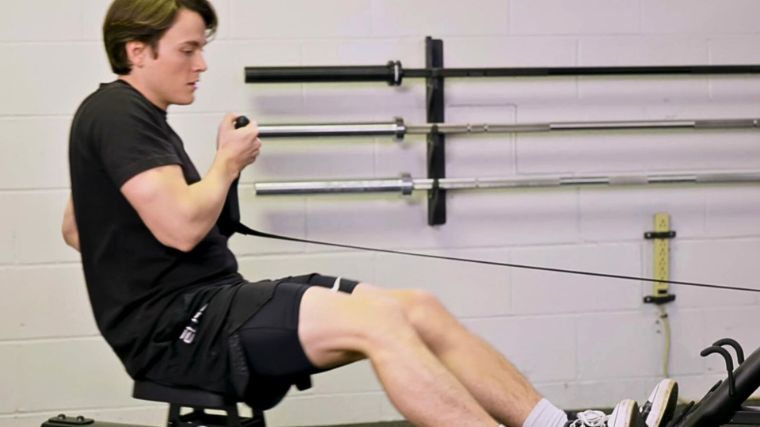
An easy way to think of it is a sprint workout. You might sprint as fast as you can for 15 seconds and then jog or walk for one minute or more to recover.
You can do any type of exercise for HIIT as long as you can fit it into the formula. You can do HIIT on a rowing machine, treadmill, bike, stair climber, in bodyweight circuits, or mix a few. HIIT is also common in CrossFit workouts.
Row, Row, Row (Your Boat)
HIIT rowing workouts are a great way to work your whole body and increase your cardiovascular fitness and stamina in as little as four minutes. Beginners can go a bit easier with equal time spent working and resting. Intermediates can try out the Tabata style of HIIT. Advanced athletes can mix in other challenging exercises with quick rowing sprints to push their limits.
Hop on your rower, push through your legs, and HIIT through your plateaus.
FAQs
Lingering question on HIIT rowing workouts?
Yes, rowing is great for HIIT. You can get a very challenging workout without leaving the machine by alternating your intensity for different lengths of time.
Twenty minutes of rowing is excellent. You can vary your intensity for an interval workout or maintain your pace for a steady-state rowing session.
It depends on your body, the length of time, and the intensity of your row. According to a physical activity calculator by ACE Fitness, a 175-pound person can burn calories during a moderate-intensity rowing session. At an extreme intensity, it goes up to 277 calories. (5)
References
- Emberts T, Porcari J, Dobers-Tein S, Steffen J, Foster C. Exercise intensity and energy expenditure of a tabata workout. J Sports Sci Med. 2013 Sep 1;12(3):612-3.
- Ito S. High-intensity interval training for health benefits and care of cardiac diseases – The key to an efficient exercise protocol. World J Cardiol. 2019 Jul 26;11(7):171-188.
- Foster C, Farland CV, Guidotti F, Harbin M, Roberts B, Schuette J, Tuuri A, Doberstein ST, Porcari JP. The Effects of High Intensity Interval Training vs Steady State Training on Aerobic and Anaerobic Capacity. J Sports Sci Med. 2015 Nov 24;14(4):747-55.
- ACE Fitness. 7 Things to Know About Excess Post-exercise Oxygen Consumption (EPOC). American Council on Exercise.
- ACE Fitness. ACE Fit | Physical Activity Calorie Calculator. American Council on Exercise.
The post The Best HIIT Rowing Workout, Customized to Your Experience Level appeared first on BarBend.

